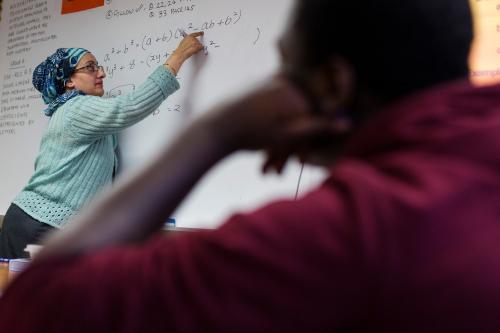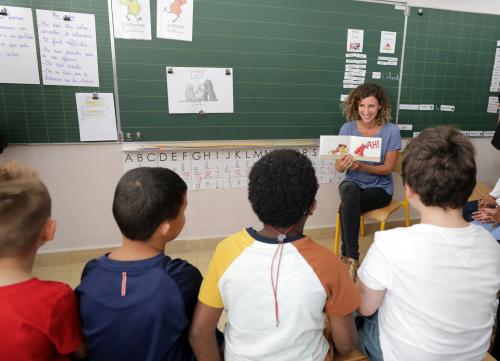This post is part of “Teacher diversity in America,” a series from the Brown Center on Education Policy that examines minority underrepresentation among public educators in the U.S.
An increasing amount of evidence shows that alignment in the racial or ethnic identity of teachers and students is associated with a range of positive student outcomes, from test scores to disciplinary actions to teacher expectations. Due to the underrepresentation of teachers of color in the current workforce, minority students stand to disproportionally benefit from efforts to increase teacher diversity.
With this evidence, it is easy for many practitioners and policymakers to take a next logical step, concluding that, because minority students tend to benefit uniquely from diverse teachers, teachers of color will be most beneficial in schools serving large numbers of minority students. Thus, any new teachers of color are often steered (whether covertly or overtly) toward high-minority schools. Taken to an extreme, given the tenacious grip of racial segregation on America’s schools, we could have a school system where the teacher workforce is every bit as diverse as its students—and perhaps every bit as segregated.
In addition to the risk of creating a racially segregated workforce, the logical leap above is misguided for at least two reasons. First, it ignores the evidence showing that teachers of color benefit white students—perhaps not always through test scores, but through pro-social beliefs and attitudes. Second, schools serving large numbers of minority students already tend to have the most racially diverse workforces, while many students of color in predominantly white schools have virtually no exposure to teachers of color.
As districts and states across the country pursue racial and ethnic diversity among teachers, we should pay attention to how teachers of color are distributed to avoid creating another layer of school segregation.
As districts and states across the country pursue racial and ethnic diversity among teachers, we should pay attention to how teachers of color are distributed to avoid creating another layer of school segregation. After briefly contextualizing segregation and its manifestations in schools, we report our findings that teachers are even more segregated than students in the U.S., suggesting the need for a new framework around the hiring of nonwhite teachers.
Many types of segregation
School segregation does not exist in a vacuum, but is part of an interconnected structure of segregation that extends to residence and employment. Residential segregation can be primarily attributed not to self-segregation of minority racial groups but instead to decades of federal policy that prevented nonwhite families from acquiring mortgages, redlining practices, the strategic placement of interstates and highways throughout the 20th century, and individual actions of white families. Employment segregation takes the form of predominantly white jobs having an average salary four times higher than that of heavily black or Hispanic jobs. Furthermore, a 2017 meta-analysis of callback rates for fake resumes with racially coded names reveals the continued presence of simple employment discrimination.
Each of these factors significantly influences the racial segregation of students across schools. Although the school integration movement achieved significant gains following the landmark 1954 Supreme Court decision on Brown v. Board of Education, many of its victories have been reversed in the past 20 years, returning the American public school system to segregation levels last seen during the Civil Rights era. Resegregation in recent decades is most apparent in looking at the number of schools with very high concentrations of minorities, which are becoming more common and even more monolithically racialized than in the past. In 2010, the average white student is just as exposed to black students as they were in 1980, while the average black student is actually less exposed to white students than they were 30 years before.
Factors segregating the teacher workforce, past and present
Understanding the history of teacher segregation helps to lay the groundwork for our analysis of teacher segregation today. This history can be clearly traced back to that same Brown decision, which ruled that separate schools for black and white students were inherently unequal and ordered that Southern schools integrate “with all deliberate speed.” As student integration began, however, teachers did not follow suit. Instead, massive layoffs for black teachers immediately followed. About 38,000 black teachers lost their job in the decades after Brown—an estimated one-third of the nation’s black teachers.
Since teaching represented one of the few paths available to the middle class for educated African-Americans, black teachers in the pre-Brown era were highly respected and held central positions in their communities. Thus, not only did these displacements represent a career loss for the black teacher and the loss of a role model or advocate for a black student, but they also symbolized the destabilizing of Southern black communities. Since this period of mass displacement, black college graduates have chosen to enter the teaching profession at decreasing rates, thanks to factors including widening career options and the rise of teacher competency tests.
These historical roots of segregation persist and teachers of color are not spread evenly across today’s public schools. Rather, schools often act as pockets of minority teachers—or pockets without. A 2011 report estimated over 40 percent of public schools do not employ a single teacher of color. Instead, teachers of color are two to three times more likely than white teachers to work in disadvantaged schools—typically urban schools with high-minority student bodies.
Segregation among teachers today is likely due at least in part to different teacher preferences. For example, both white and nonwhite teachers report higher job satisfaction and turn over less frequently when their principal is their same race. Kirabo Jackson evaluated changes in the teacher workforce when North Carolina’s Charlotte-Mecklenburg Schools quit busing students and found teachers partially resegregated along with students. Furthermore, a survey of black male teachers reports that those who are the lone black teacher in their school had more negative perceptions of their working environment, compared to those who had four or more black colleagues.
In addition, districts’ hiring and placement practices certainly play a part in continuing segregation as well. The latest research on this topic, conducted by professors at George Mason University, reveals that, in one large school district, white teachers were hired at a disproportionate rate compared to how often they applied. On the other hand, black teachers disproportionately received offers from black principals—if they got an offer at all. Black teachers were also much more likely to be hired in low-income schools.
Teacher versus student segregation nationwide
How does teacher segregation compare to the level of student segregation in the country? We use school enrollment and teacher staffing data from the National Teacher and Principal Survey (NTPS) to compute two types of segregation measures, which we explain in turn.
The first type is a dissimilarity measure, a numerical value between 0 and 1 that is often interpreted as the share of the minority group that would need to switch schools to achieve perfect integration across schools. For simplicity, we calculate this measure between two racial groups: white and nonwhite. When we compute this statistic for teachers across all schools nationwide, we find a dissimilarity index of 0.61. In other words, three of every five nonwhite teachers would need to be reassigned in order to achieve even distribution across schools. Remarkably, this is larger than the analogous dissimilarity computed among students in the same sample, which comes out of 0.56.
Computing a dissimilarity index nationwide masks underlying regional demographic differences. We use data from the Schools and Staffing Survey to compute state-level dissimilarity measures because the NTPS is not representative at the state level. Yet, even state-level dissimilarity index measures show teachers in 40 states exceed the state-level student dissimilarity index. Maps of both are presented below for comparison—it is visibly apparent that high dissimilarity is far more common among teachers than students.
To be clear, we have no expectation that this dissimilarity measure should be zero. Many teachers of color enter the profession precisely because they desire to work in schools that serve their own communities. Yet, current levels of student segregation are widely viewed as problematic; teacher segregation measures above those of students raise serious questions about structural racism in teacher hiring and assignment practices.
The second type of segregation measure is exposure, representing the average level of exposure between races within a school. This measure also takes on values between 0 and 1, where 0 represents low exposure. We can compute different exposure measures depending on which group’s exposure we care about. When calculating the exposure of nonwhite students to nonwhite teachers, we estimate it to be 0.32—in other words, the average nonwhite student in the data is in a school where nonwhite teachers account for nearly a third of all teachers.
When we calculate white student exposure to nonwhite teachers, we estimate it to be far lower: 0.09. The large discrepancy in these numbers indicate vastly different experiences for students, depending on which types of schools they attend. For the many nonwhite students who attend predominantly white schools, their chances of exposure to teachers of similar backgrounds are discouragingly low.
Which students should get more teachers of color?
In this post, we have endeavored to explore racial segregation among teachers in public schools, and its relation to student segregation. We find racial segregation is actually higher among teachers than students, a surprising result given how much more autonomy teachers (but not students) ostensibly benefit from in choosing schools. This finding compels us to ask whether the current distribution of teachers of color is doing the most good for students.
This analysis sends a clear signal that nonwhite teachers are needed in far more places than we currently have them, and those many schools with no teachers of color are the places that need them most.
In our view, informed by both evidence and values, teachers of color should be more evenly distributed across schools. Recent findings suggest the impressive benefits of racial matching between students and teachers do not appear to increase with dosage. Stated differently, a segregated faculty of black teachers for black students offers no obvious matching benefit beyond that expected by a diverse series of teachers over time. Instead, the ideals of a democratic, multicultural society are most likely to be advanced when teachers and leaders in our schools model that diversity for the nation’s youth.
While we applaud the efforts of many districts to promote diverse teacher recruitment, most of these efforts have come from locales with high populations of minority student groups and already hire diverse teachers in fairly large numbers. This analysis and other findings in our teacher diversity series send a clear signal that nonwhite teachers are needed in far more places than we currently have them, and those many schools with no teachers of color are the places that need them most.
Bethany Kirkpatrick contributed to this post.










Commentary
Teachers in the US are even more segregated than students
August 15, 2018